General, Sir John Monash, Personal Files Book 19, 7 July - 30 July 1918- Part 11
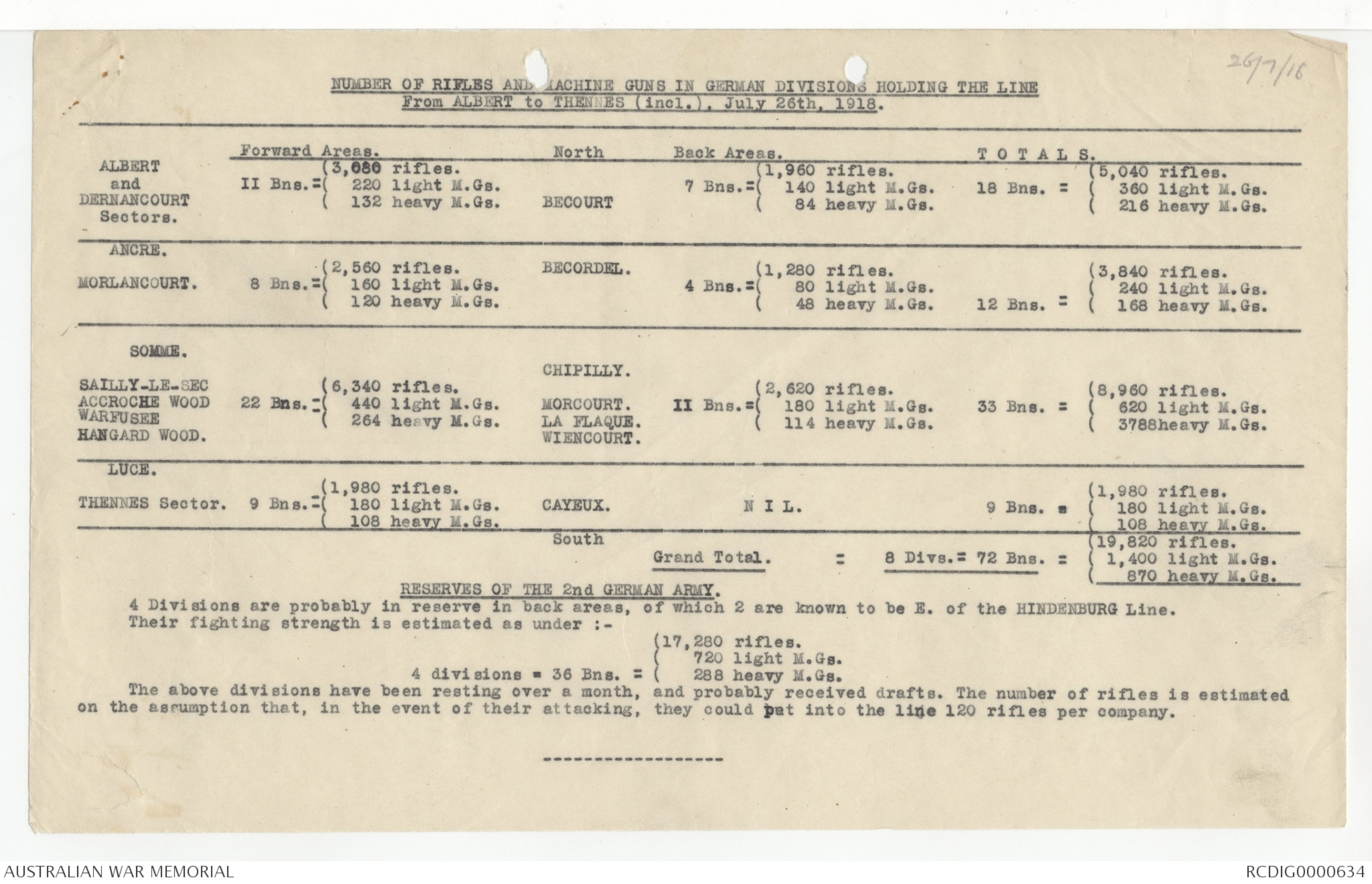
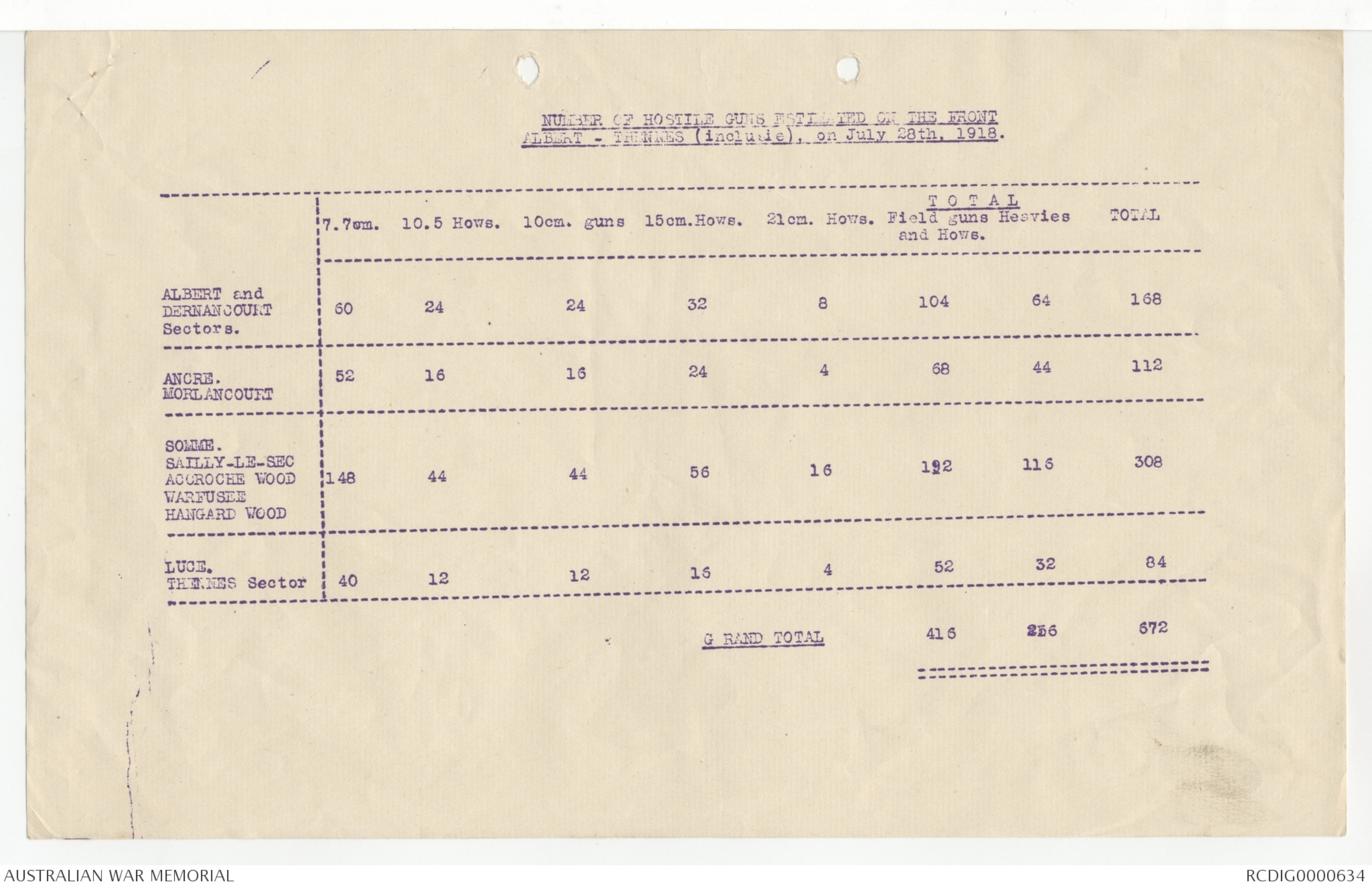
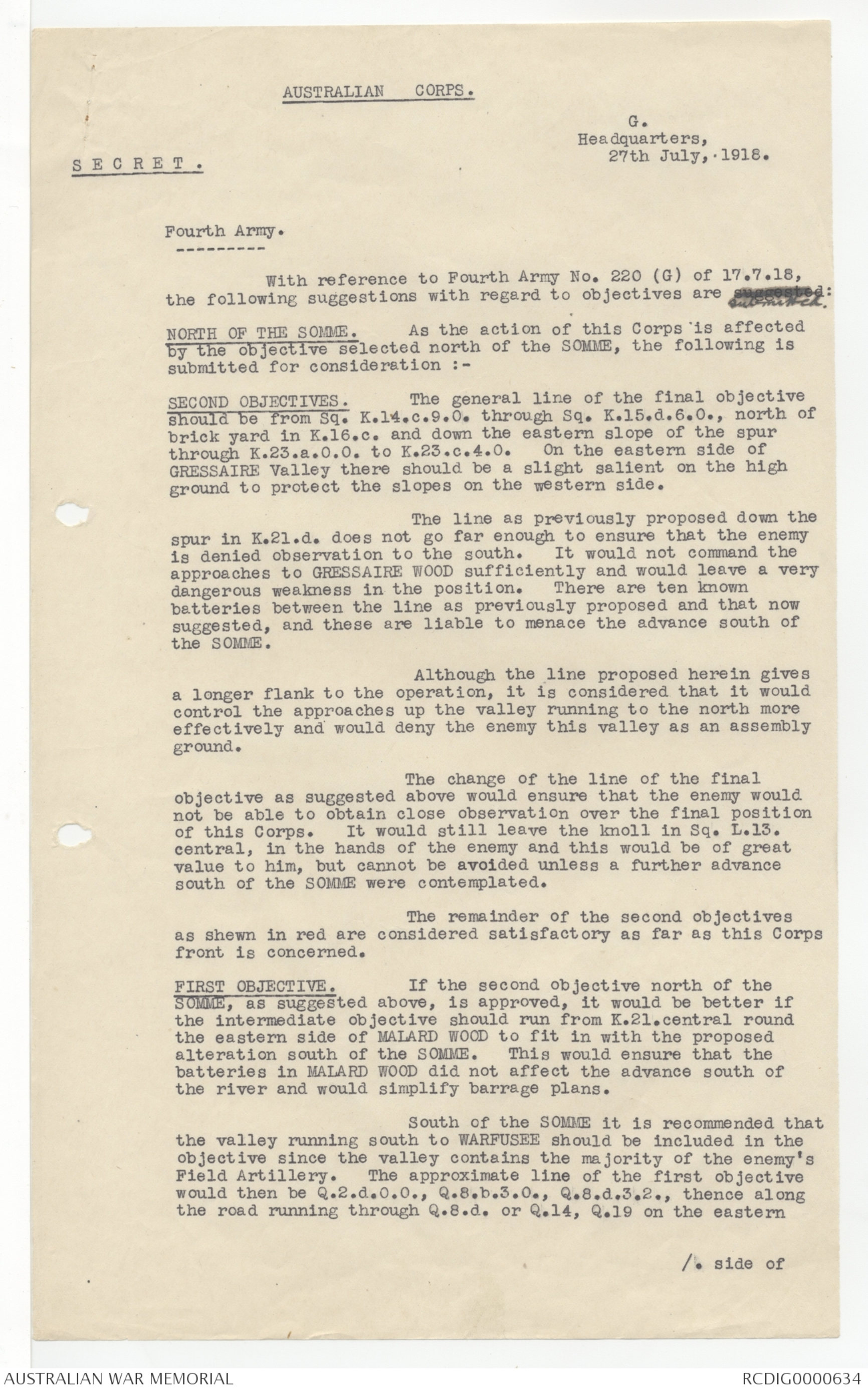
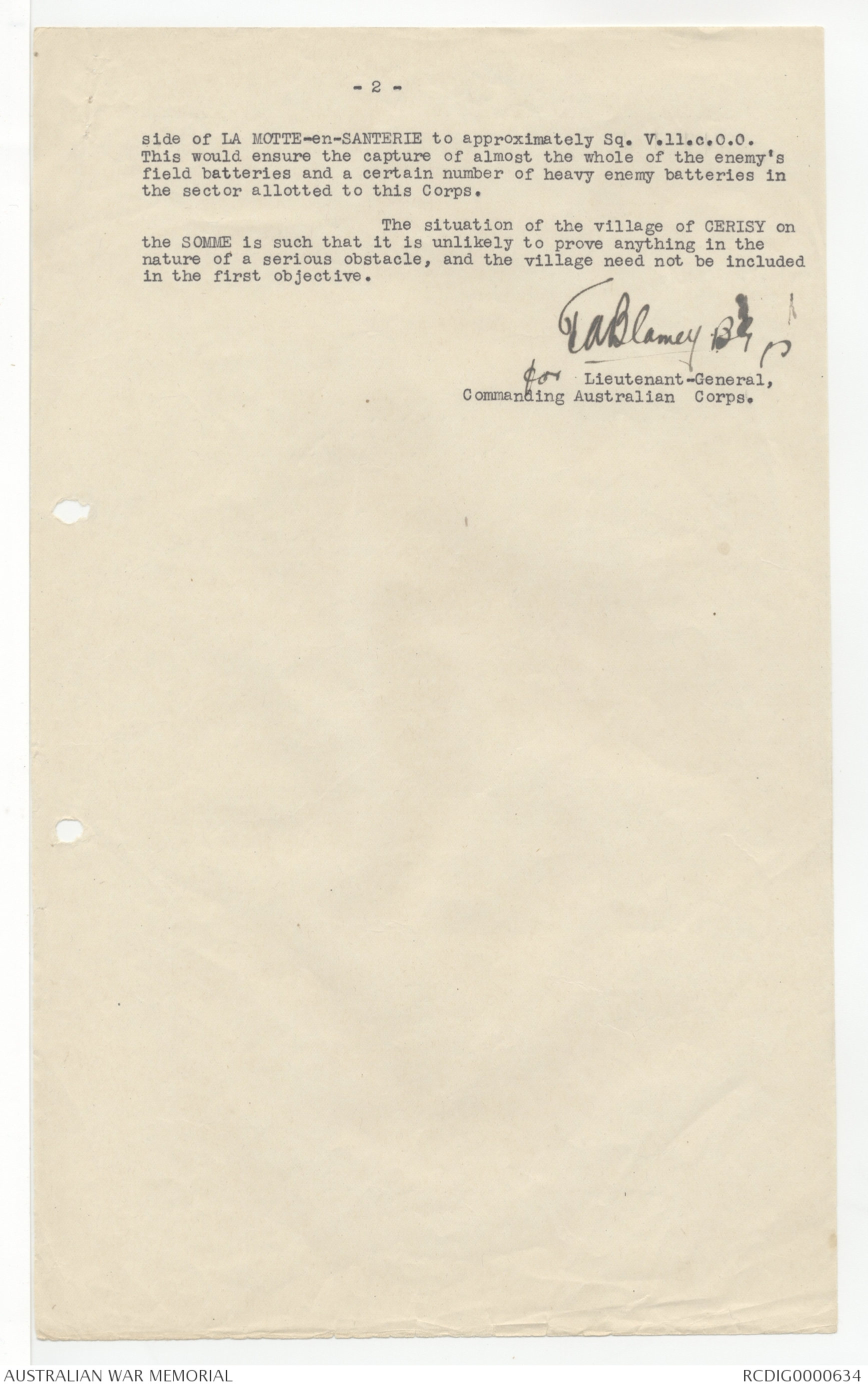
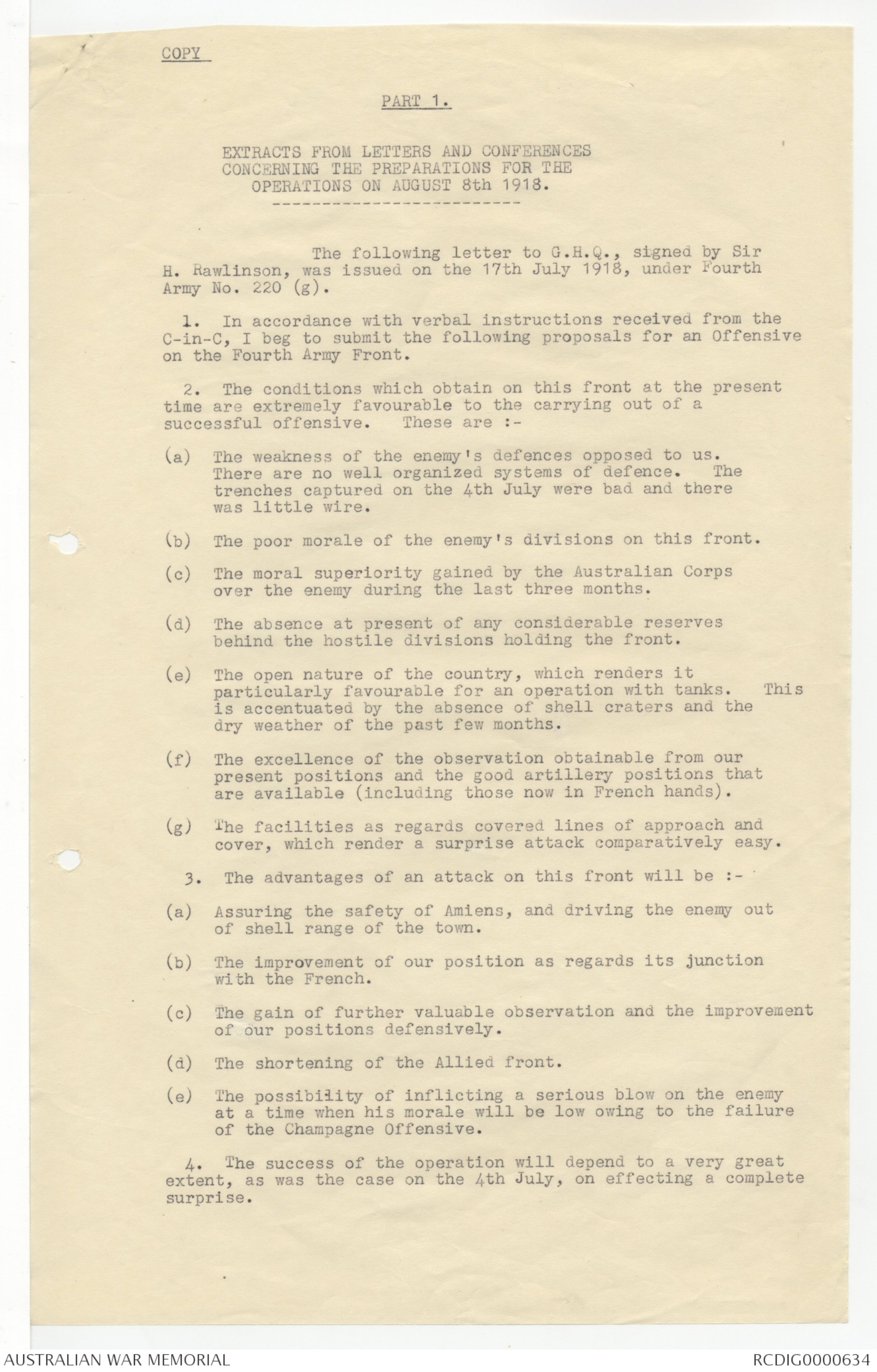
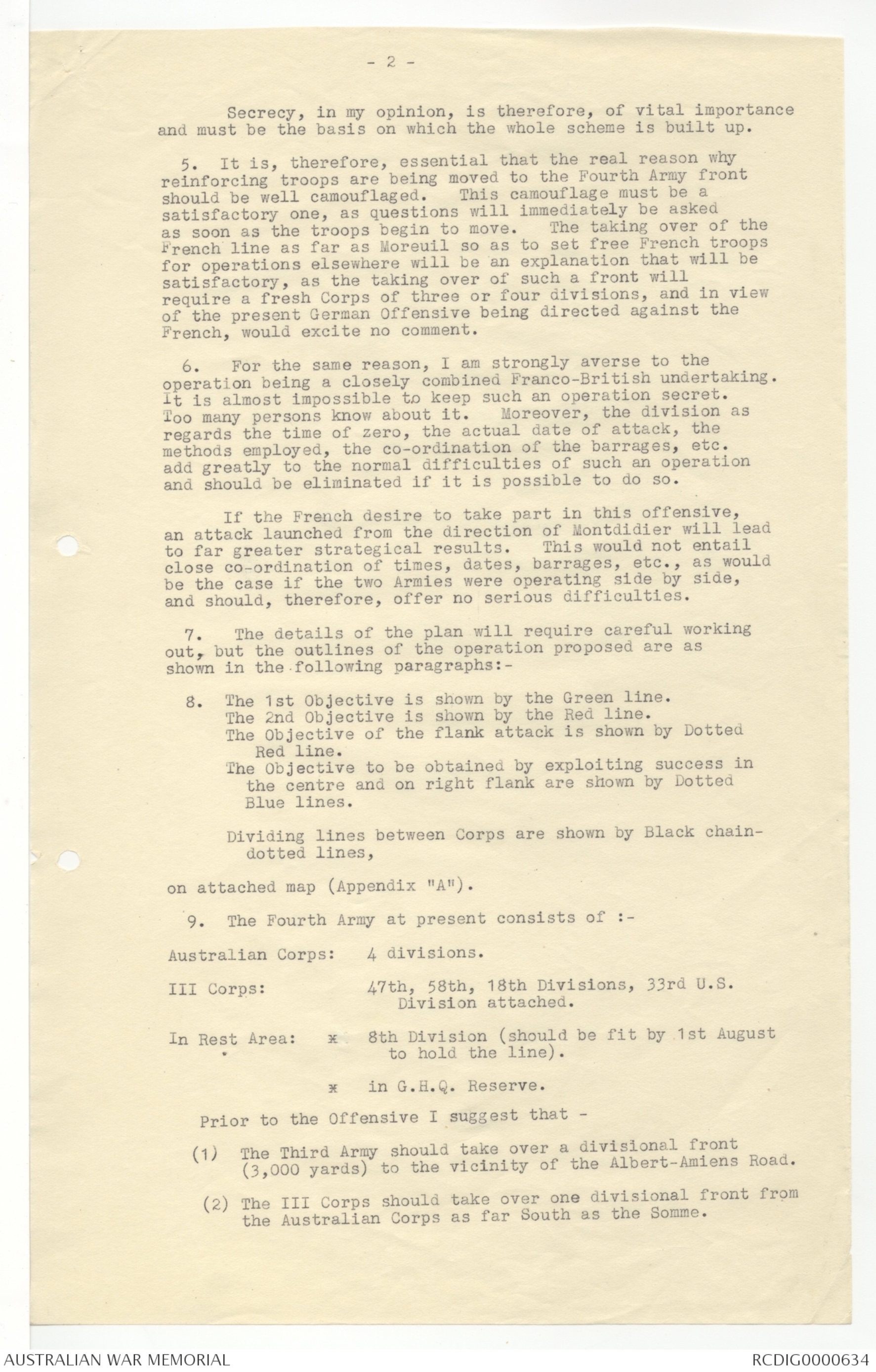
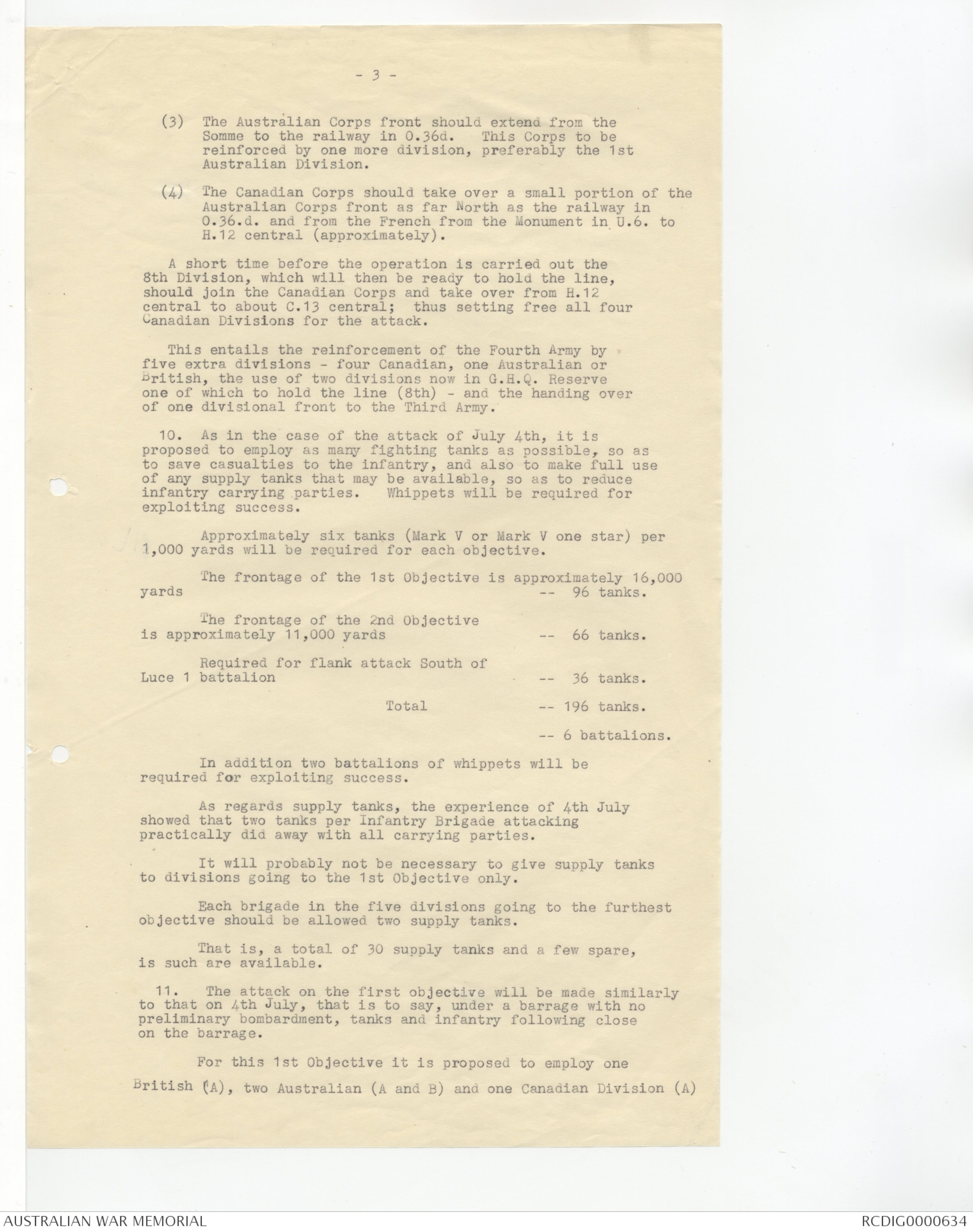
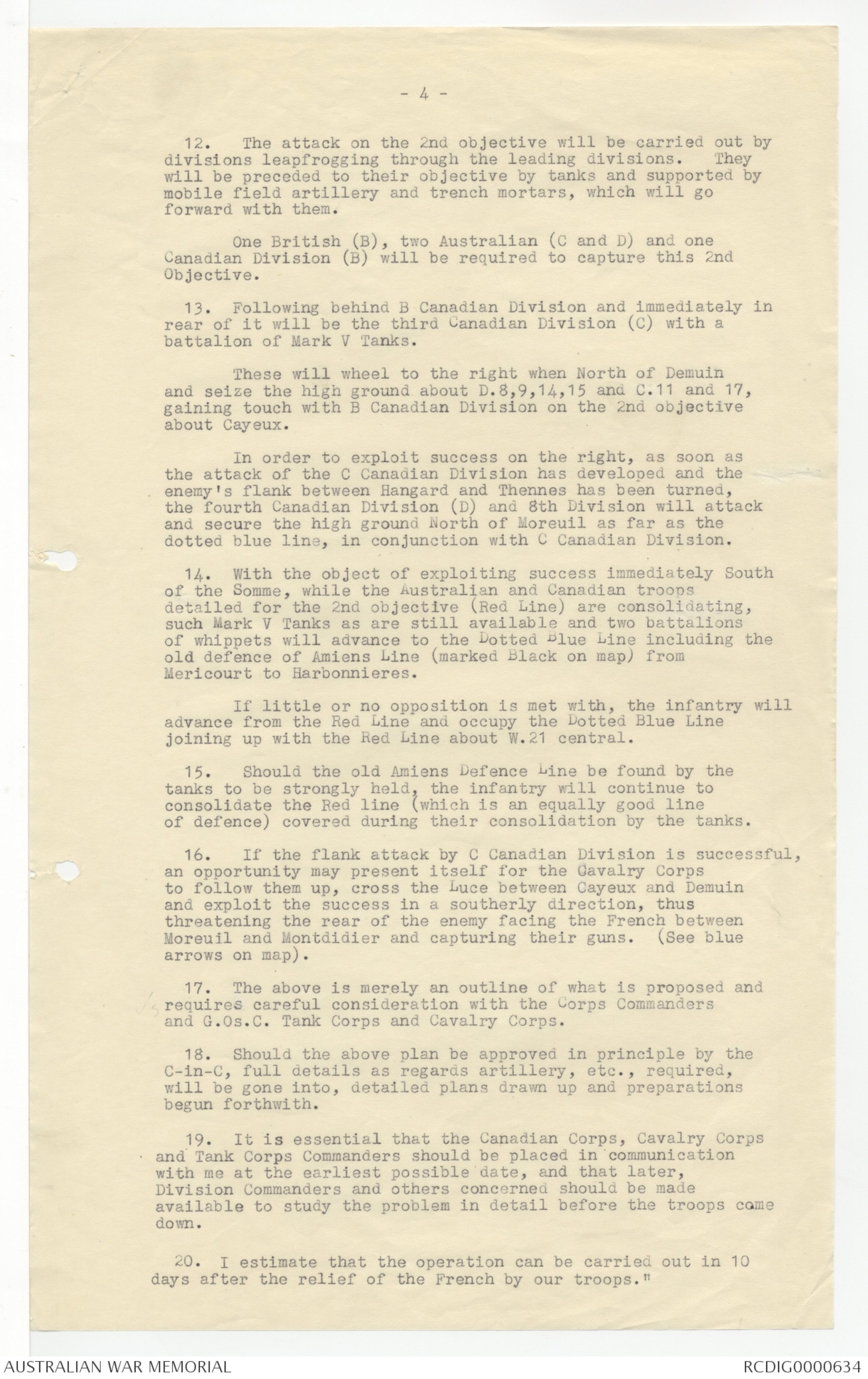
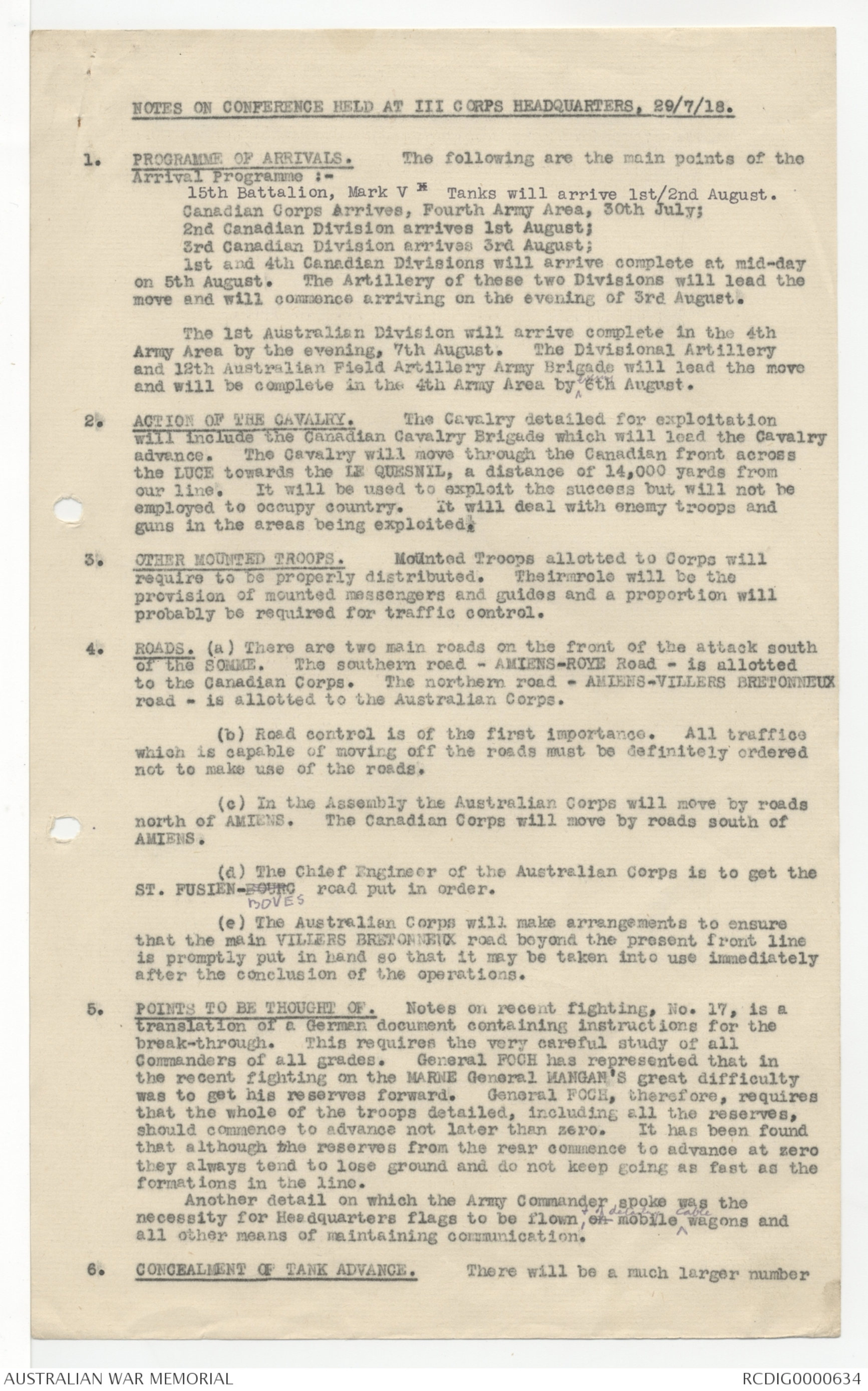
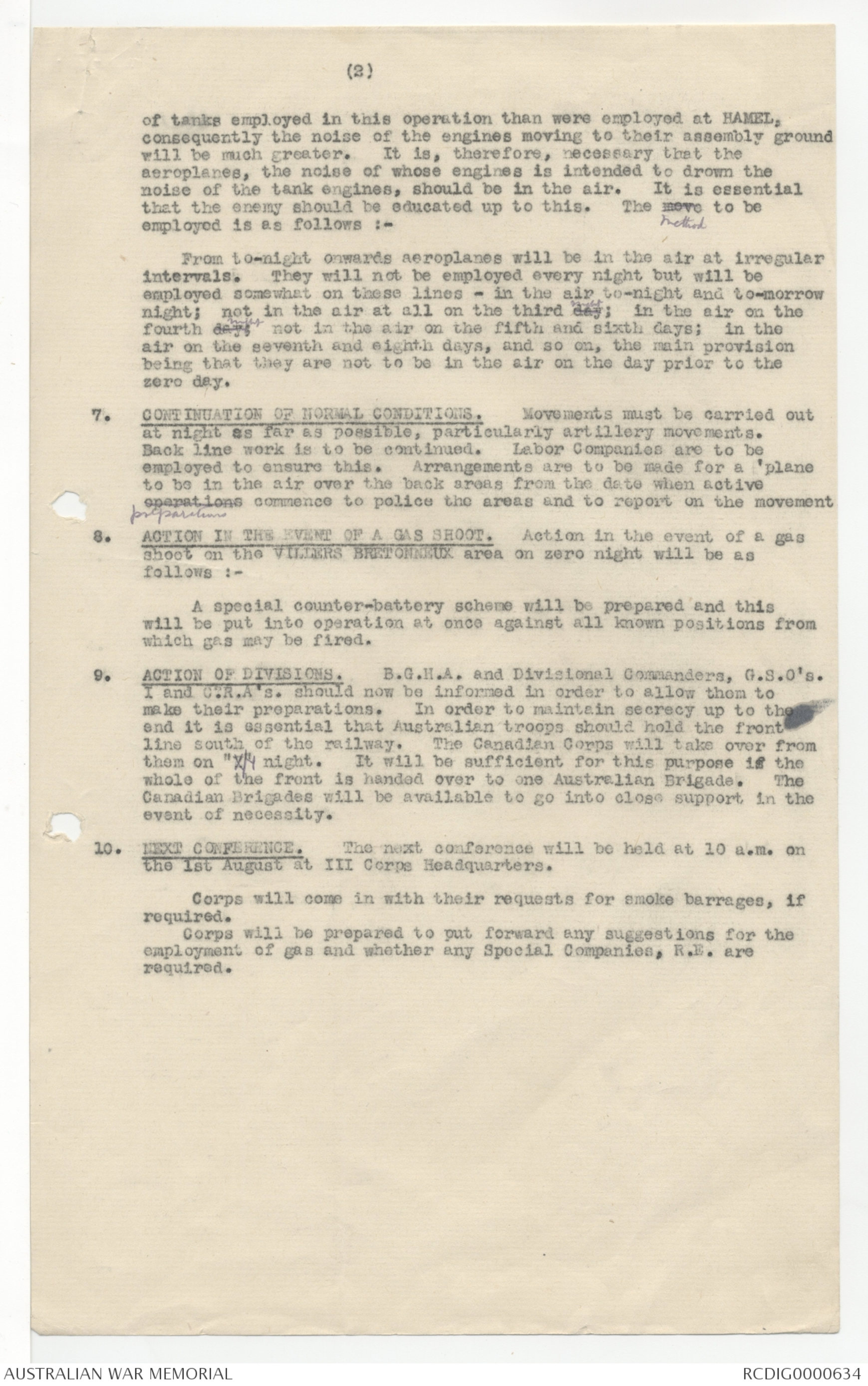
26/7/16
| NUMBER OF RIFLES AND MACHINE GUNS IN GERMAN DIVISIONS HOLDING THE LINE | |||||||
| From ALBERT to THENNES (Incl.), July 26th, 1918. | |||||||
| Forward Areas. | North | Back Areas. | TOTALS. | ||||
| ALBERT And DERNANCOURT Sectors. |
II Bns. = | (3,680 rifles ( 220 light M.Gs. ( 132 heavy M.Gs. |
BECOURT | 7 Bns. = | (1,960 rifles ( 140 light M.Gs. ( 84 heavy M.Gs. |
18 Bns. = | (5,040 rifles ( 360 light M.Gs. ( 216 heavy M.Gs. |
| ANCRE. MORLANCOURT. |
8 Bns. = | (2,560 rifles ( 160 light M.Gs. ( 120 heavy M.Gs. |
BECORDEL. | 4 Bns. = | (1,280 rifles ( 80 light M.Gs. ( 48 heavy M.Gs. |
12 Bns. = | (3,840 rifles ( 240 light M.Gs. ( 168 heavy M.Gs. |
| SOMME. SAILLY_LE_SEC ACCROCHE WOOD WARFUSEE HARNGARD WOOD. |
22 Bns. = | (6,340 rifles ( 440 light M.Gs. ( 264 heavy M.Gs. |
CHIPILLY. MORCOURT. LA FLAQUE. WIENCOURT. |
II Bns. = | (1,960 rifles ( 140 light M.Gs. ( 84 heavy M.Gs. |
33 Bns. = | (8,960 rifles ( 620 light M.Gs. ( 3788 heavy M.Gs. |
| LUCE. THENNES Sector. |
9 Bns. = | (1,980 rifles ( 180 light M.Gs. ( 108 heavy M.Gs. |
CAYEUX. | NIL | 9 Bns. = | (1,980 rifles ( 180 light M.Gs. ( 108 heavy M.Gs. |
|
| South | Grand Total = 8 Divs. = | 72 Bns. | (19,820 rifles ( 1,400 light M.Gs. ( 870 heavy M.Gs. |
||||
RESERVES OF THE 2nd GERMAN ARMY.
4 Divisions are probably in reserve in back areas, of which 2 are known to be E. of the HINDENBURG Line.
Their fighting strength is estimates as under:-
(17,280 rifles.
( 720 light M.Gs.
4 divisions = 36 Bns. = ( 288 heavy M.Gs.
The above divisions have been resting over a month, and probably received drafts. The number of rifles is estimated
on the assumption that, in the event of their attacking, they could laput into the [[lijne]] 120 rifles per company.
| NUMBER OF HOSTILE GUNS ESTIMATED ON THE FRONT | ||||||||
| ALBERT – THENNES (inclusie), on July 28th, 1918. | ||||||||
| TOTAL | ||||||||
| 7.7 |
10.5 Hows. | 10 cm. Guns | 15 cm. Hows. | 21 cm. Hows. | Field guns And Hows. |
Heavies | TOTAL | |
| ALBERT and DERNANCOURT Sectors. |
60 | 24 | 24 | 32 | 8 | 104 | 64 | 168 |
| ANCRE. MORLANCOURT. |
52 | 16 | 16 | 24 | 4 | 68 | 44 | 112 |
| SOMME. SAILLY-LE-SEC ACCROCHE WOOD WARFUSEE HANGARD WOOD |
148 | 44 | 44 | 56 | 16 | [[192]] | 116 | 308 |
| LUCE. THENNES Sector |
40 | 12 | 12 | 16 | 4 | 52 | 32 | 84 |
| GRAND TOTAL | 416 | [[2 |
672 | |||||
AUSTRALIAN CORPS.
SECRET.
G.
Headquarters,
27th July,·1918.
Fourth Army.
With reference to Fourth Army No. 220 (G) of 17.7.18,
the following suggestions with regard to objectives suggested: submitted.
NORTH OF THE SOMME. As the action of this Corps is affected
by the objective selected north of the SOMME, the following is
submitted for consideration:-
SECOND OBJECTIVES. The general line of the final objective
should be from Sq. K.14.c.9.0. through Sq. K.15.d.6.0., north of
brick yard in K.l6.c. and down the eastern slope of the spur
through K.25.a.0.0. to K.23.c.4.0. On the eastern side of
GRESSAIRE Valley there should be a slight salient on the high
ground to protect the slopes on the western side.
The line as previously proposed down the
spur in K.21.d. does not go far enough to ensure that the enemy
is denied observation to the south. It would not command the
approaches to GRESSAIRE WOOD sufficiently and would leave a very
dangerous weakness in the position. There are ten known
batteries between the line as previously proposed and that now
suggested, and these are liable to menace the advance south of
the SOMME.
Although the line proposed herein gives
a longer flank to the operation, it is considered that it would
control the approaches up the valley running to the north more
effectively and would deny the enemy this valley as an assembly
ground.
The change of the line of the final
objective as suggested above would ensure that the enemy would
not be able to obtain close observation over the final position
of this Corps. It would still leave the knoll in Sq. L.13.
central, in the hands of the enemy and this would be of great
value to him, but cannot be avoided unless a further advance
south of the SOMME were contemplated.
The remainder of the second objectives
as shown in red are considered satisfactory as far as this Corps
front is concerned.
FIRST OBJECTIVE. If the second objective north of the
SOMME, as suggested above, is approved, it would be better if
the intermediate objective should run from K.21. central round
the eastern side of MALARD WOOD to fit in with the proposed
alteration south of the SOMME. This would ensure that the
batteries in MALARD WOOD did not affect the advance south of
the river and would simplify barrage plans.
South of the SOMME it is recommended that
the valley running south to WARFUSEE should be included in the
objective since the valley contains the majority of the enemy's
Field Artillery. The approximate line of the first objective
would then be Q.2.d.0.0., Q.8.b.3.0., Q.8.d.3.2., thence along
the road running through Q.8.d. or Q.14, Q.19 on the eastern
/.side of
-2-
side of LA MOTTE-en-SANTERIE to approximately Sq. V.11.c.0.0.
This would ensure the capture of almost the whole of the enemy's
field batteries and a certain number of heavy batteries in
the sector allocated to this Corps.
The situation of the village of CERISY on
the SOMME is such that it is unlikely to prove anything in the
nature of a serious obstacle, and the village need not be included
in the first objective.
T A Blamey BG
for Lieutenant-General,
Commanding Australian Corps.
COPY
PART 1.
EXTRACTS FROM LETTERS AND CONFERENCES
CONCERNING THE PREPARATIONS FOR THE
OPERATIONS ON AUGUST 8th 1918.
The following letter to G.H.Q., signed by Sir
H. Rawlinson, was issued on the 17th July 1918, under Fourth
Army No. 220 (g).
1. In accordance with verbal instructions received from the
C-in-C, I beg to submit the following proposals for an Offensive
on the Fourth Army Front.
2. The conditions which obtain on this front at the present
time are extremely favourable to the carrying out of a
successful offensive. These are :-
(a) The weakness of the enemy's defences opposed to us.
There are no well organized systems of defence. The
trenches captured on the 4th July were bad and there
was little wire.
(b) The poor morale of the enemy's divisions on this front.
(c) The moral superiority gained by the Australian Corps
over the enemy during the last three months.
(d) The absence at present of any considerable reserves
behind the hostile divisions holding the front.
(e) The open nature of the country, which renders it
particularly favourable for an operation with tanks. This
is accentuated by the absence of shell craters and the
dry weather of the past few months.
(f) The excellence of the observation obtainable from our
present positions and the good artillery positions that
are available (including those now in French hands).
(g) The facilities as regards covered lines of approach and
cover, which render a surprise attack comparatively easy.
3. The advantages of an attack on this front will be :-
(a) Assuring the safety of Amiens, and driving the enemy out
of shell range of the town.
(b) The improvement of our position as regards its junction
with the French.
(c) The gain of further valuable observation and the improvement
of our positions defensively.
(d) The shortening of the Allied front.
(e) The possibility of inflicting a serious blow on the enemy
at a time when his morale will be low owing to the failure
of the Champagne Offensive.
4. The success of the operation will depend to a very great
extent, as was the case on the 4th July, on effecting a complete
surprise.
- 2 -
Secrecy, in my opinion, is therefore, of vital importance
and must be the basis on which the whole scheme is built up.
5. It is, therefore, essential that the real reason why
reinforcing troops are being moved to the Fourth Army front
should be well camouflaged. This camouflage must be a
satisfactory one, as questions will immediately be asked
as soon as the troops begin to move. The taking over of the
French line as far as Moreuil so as to set free French troops
for operations elsewhere will be an explanation that will be
satisfactory, as the taking over of such a front will
require a fresh Corps of three or four divisions, and in view
of the present German Offensive being directed against the
French, would excite no comment.
6. For the same reason, I am strongly averse to the
operation being a closely combined Franco-British undertaking.
It is almost impossible to keep such an operation secret.
Too many persons know about it. Moreover, the division as
regards the time of zero, the actual date of attack, the
methods employed, the co-ordination of the barrages, etc.
add greatly to the normal difficulties of such an operation
and should be eliminated if it is possible to do so.
If the French desire to take part in this offensive,
an attack launched from the direction of Montdidier will lead
to far greater strategical results. This would not entail
close co-ordination of times, dates, barrages, etc., as would
be the case if the two Armies were operating side by side,
and should, therefore, offer no serious difficulties.
7. The details of the plan will require careful working
out, but the outlines of the operation proposed are as
shown in the following paragraphs:-
8. The 1st Objective is shown by the Green line.
The 2nd Objective is shown by the Red line.
The Objective of the flank attack is shown by Dotted
Red line.
The Objective to be obtained by exploiting success in
the centre and on right flank are shown by Dotted
Blue lines.
Dividing lines between Corps are shown by Black chain-
dotted lines,
on attached map (Appendix "A").
9. The Fourth Army at present consists of :-
| Australian Corps: | 4 divisions. |
| III Corps: | 47th, 58th, 18th Divisions, 33rd U.S. Division attached. |
| In Rest Area: | ӿ 8th Division (should be fit by 1st August to hold the line). ӿ in G.H.Q. Reserve. |
Prior to the Offensive I suggest that -
(1) The Third Army should take over a divisional front
(3,000 yards) to the vicinity of the Albert-Amiens Road.
(2) The III Corps should take over one divisional front from
the Australian Corps as far South as the Somme.
- 3 -
(3) The Australian Corps front should extend from the
Somme to the railway in 0.36d. This Corps to be
reinforced by one more division, preferably the 1st
Australian Division.
(4) The Canadian Corps should take over a small portion of the
Australian Corps front as far North as the railway in
0.36.d. and from the French from the Monument in U.6. to
H.12 central (approximately).
A short time before the operation is carried out the
8th Division, which will then be ready to hold the line,
should join the Canadian Corps and take over from H.12
central to about C.13 central; thus setting free all four
Canadian Divisions for the attack.
This entails the reinforcement of the Fourth Army by
five extra divisions - four Canadian, one Australian or
British, the use of two divisions now in G.H.Q. Reserve
one of which to hold the line (8th) - and the handing over
of one divisional front to the Third Army.
10. As in the case of the attack of July 4th, it is
proposed to employ as many fighting tanks as possible, so as
to save casualties to the infantry, and also to make full use
of any supply tanks that may be available, so as to reduce
infantry carrying parties. Whippets will be required for
exploiting success.
Approximately six tanks (Mark V or Mark V one star) per
1,000 yards will be required for each objective.
The frontage of the 1st Objective is approximately 16,000
yards -- 96 tanks.
The frontage of the 2nd Objective
is approximately 11,000 yards -- 66 tanks.
Required for flank attack South of
Luce 1 battalion -- 36 tanks.
Total -- 196 tanks.
-- 6 battalions.
In addition two battalions of whippets will be
required for exploiting success.
As regards supply tanks, the experience of 4th July
showed that two tanks per Infantry Brigade attacking
practically did away with all carrying parties.
It will probably not be necessary to give supply tanks
to divisions going to the 1st Objective only.
Each brigade in the five divisions going to the furthest
objective should be allowed two supply tanks.
That is, a total of 30 supply tanks and a few spare,
is such are available.
11. The attack on the first objective will be made similarly
to that on 4th July, that is to say, under a barrage with no
preliminary bombardment, tanks and infantry following close
on the barrage.
For this 1st Objective it is proposed to employ one
British (1A), two Australian (A and B) and one Canadian Division (A)
- 4 -
12. The attack on the 2nd objective will be carried out by
divisions leapfrogging through the leading divisions. They
will be preceded to their objective by tanks and supported by
mobile field artillery and trench mortars, which will go
forward with them.
One British (B), two Australian (C and D) and one
Canadian Division (B) will be required to capture this 2nd
Objective.
13. Following behind B Canadian Division and immediately in
rear of it will be the third Canadian Division (C) with a
battalion of Mark V Tanks.
These will wheel to the right when North of Demuin
and seize the high ground about D.8,9,14,15 and C.11 and 17,
gaining touch with B Canadian Division on the 2nd objective
about Cayeux.
In order to exploit success on the right, as soon as
the attack of the C Canadian Division has developed and the
enemy's flank between Hangard and Thennes has been turned,
the fourth Canadian Division (D) and 8th Division will attack
and secure the high ground North of Moreuil as far as the
dotted blue line, in conjunction with C Canadian Division.
14. With the object of exploiting success immediately South
of the Somme, while the Australian and Canadian troops
detailed for the 2nd objective (Red Line) are consolidating,
such Mark V Tanks as are still available and two battalions
of whippets will advance to the Dotted Blue Line including the
old defence of Amiens Line (marked Black on map) from
Mericourt to Harbonnieres.
If little or no opposition is met with, the infantry will
advance from the Red Line and occupy the Dotted Blue Line
joining up with the Red Line about W.21 central.
15. Should the old Amiens Defence Line be found by the
tanks to be strongly held, the infantry will continue to
consolidate the Red line (which is an equally good line
of defence) covered during their consolidation by the tanks.
16. If the flank attack by C Canadian Division is successful,
an opportunity may present itself for the Cavalry Corps
to follow them up, cross the Luce between Cayeux and Demuin
and exploit the success in a southerly direction, thus
threatening the rear of the enemy facing the French between
Moreuil and Montdidier and capturing their guns. (See blue
arrows on map).
17. The above is merely an outline of what is proposed and
requires careful consideration with the Corps Commanders
and G.0s.C. Tank Corps and Cavalry Corps.
18. Should the above plan be approved in principle by the
C-in-C, full details as regards artillery, etc., required,
will be gone into, detailed plans drawn up and preparations
begun forthwith.
19. It is essential that the Canadian Corps, Cavalry Corps
and Tank Corps Commanders should be placed in communication
with me at the earliest possible date, and that later,
Division Commanders and others concerned should be made
available to study the problem in detail before the troops come
down.
20. I estimate that the operation can be carried out in 10
days after the relief of the French by our troops."
NOTES ON CONFERENCE AT III CORPS HEADQUARTERS, 29/7/18.
1. PROGRAMME OF ARRIVALS. The following are the main points of the
Arrival Programme:-
15th Battalion, Mark V ӿ Tanks will arrive 1st/2nd August.
Canadian Corps Arrives, Fourth Army Area, 30th July;
2nd Canadian Division arrives 1st August;
3rd Canadian Division arrives 3rd August;
1st and 4th Canadian Divisions will arrive complete at mid-day
on 5th August. The Artillery of these two Divisions will lead the
move and will commence arriving on the evening of 3rd August.
The 1st Australian Division will arrive complete in the 4th
Army Area by the evening, 7th August. The Divisional Artillery
and 12th Australian Field Artillery Army Brigade will lead the move
and will be complete in the 4th Army Area by ^[[evening?]] 6th August.
2. ACTION OF THE CAVALRY. The Cavalry detailed for exploitation
will include the Canadian Cavalry Brigade which will lead the Cavalry
advance. The Cavalry will move through the Canadian front across
the LUCE towards the LE QUESNIL, a distance of 14,000 yards from
our line. It will be used to exploit the success but will not be
employed to occupy country. It will deal with enemy troops and
guns in the areas being exploited[[½?]].
3. OTHER MOUNTED TROOPS. Mo[[U?]]unted Troops allotted to Corps will
require to be properly distributed. Theirmrole will be the
provision of mounted messengers and guides and a proportion will
probably be required for traffic control.
4. ROADS. (a) There are two main roads on the front of the attack south
of the SOMME. The southern road - AMIENS-ROYE Road - is allotted
to the Canadian Corps. The northern road - AMIENS-VILLERS BRETONNEUX
road - is allotted to the Australian Corps.
(b) Road control is of the first importance. All traffice
which is capable of moving off the roads must be definitely ordered
not to make use of the roads.
(c) In the Assembly the Australian Corps will move by roads
north of AMIENS. The Canadian Corps will move by roads south of
AMIENS.
(d) The Chief Engineer of the Australian Corps is to get the
ST. FUSIEN-BOURC^BOVES road put in order.
(e) The Australian Corps will make arrangements to ensure
that the main VILLERS BRETONNEUX road beyond the present front line
is promptly put in hand so that it may be taken into use immediately
after the conclusion of the operations.
5. POINTS TO BE THOUGHT OF. Notes on recent fighting, No. 17, is a
translation of a German document containing instructions for the
break-through. This requires the very careful study of all
Commanders of all grades. General FOCH, has represented that in
the recent fighting on the MARNE General MANGAN'S great difficulty
was to get his reserves forward. General FOCH, therefore, requires
that the whole of the troops detailed, including all the reserves,
should commence to advance not later than zero. It has been found
that although the reserves from the rear commence to advance at zero
they always tend to lose ground and do not keep going as fast as the
formations in the line.
Another detail on which the Army Commander spoke was the
necessity for Headquarters flags to be flown, ^& of [[?decasting]] on mobile ^cable wagons and
all other means of maintaining communication.
6. CONCEALMENT OF TANK ADVANCE. There will be a much larger number
(2)
of tanks employed in this operation than were employed at HAMEL,
consequently the noise of the engines moving to their assembly ground
will be much greater. It is, therefore, necessary that the
aeroplanes, the noise of whole engines is intended to drown the
noise of the tank engines, should be in the air. It is essential
that the enemy should be educated up to this. The move ^ method to be
employed is as follows :-
From to-night onwards aeroplanes will be in the air at irregular
intervals. They will not be employed every night but will be
employed somewhat on these lines - in the air to-night and to-morrow
night; not in the air at all on the third day ^ night; in the air on the
fourth day ^ night; not in the air on the fifth and sixth days; in the
air on the seventh and eighth days, and so on, the main provision
being that they are not to be in the air on the day prior to the
zero day.
7. CONTINUATION OF NORMAL CONDITIONS. Movements must be carried out
at night as far as possible, particularly artillery movements.
Back line work is to be continued. Labor Companies are to be
employed to ensure this. Arrangements are to be made for a ‘plane
to be in the air over the back areas from the date when activeoperations ^ preparations commence to police the areas and to report on the movement
8. ACTION IN THE EVENT OF A GAS SHOOT. Action in the event of a gas
shoot on the VILLERS BRETENNEUX area on zero night will be as
follows:-
A special counter-battery scheme will be prepared and this
will be put into operation at once against all known positions from
which gas may be fired.
9. ACTION OF DIVISIONS. B.G.H.A. and Divisional Commanders, G.S.O's.
I and C?.R.A's. should now be informed in order to allow them to
make their preparations. In order to maintain secrecy up to the
end it is essential that Australian troops should hold the front
line south of the railway. The Canadian. Corps will take over from
them on "X"/Y night. It will be sufficient for this purpose isf the
whole of the front is handed over to one Australian Brigade. The
Canadian Brigades will be available to go into close support in the
event of necessity.
10. NEXT CONFERENCE. The next conference will be held. at 10 a.m. on
the 1st August at III Corps Headquarters.
Corps will come in with their requests for smoke barrages, if
required.
Corps will be prepared to put forward any suggestions for the
employment of gas and whether any Special Companies, R.E. are
required.
 Sam scott
Sam scottThis transcription item is now locked to you for editing. To release the lock either Save your changes or Cancel.
This lock will be automatically released after 60 minutes of inactivity.